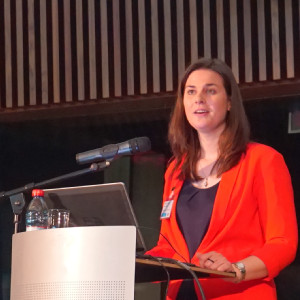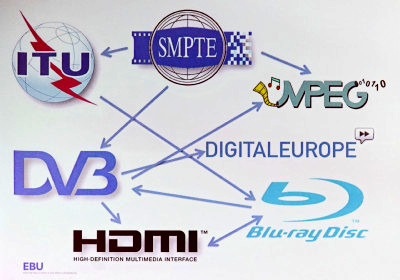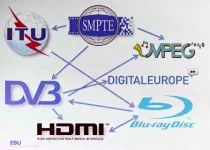 Yvonne Thomas is from the EBU and she looked at standards for UltraHD. She said that the aim with UltraHD, as Mark Twain said is to “please some and astonish the rest”.
Yvonne Thomas is from the EBU and she looked at standards for UltraHD. She said that the aim with UltraHD, as Mark Twain said is to “please some and astonish the rest”.
The main body that decides on broadcasting standards is the ITU which has two working parties looking at UltraHD.
- Working Party 6B is working on UHDTV 6G/12G/24 SDI interfaces for broadcast content capture and production.
- Working Party 6C is looking at BT 2020, RG-24 for EIDR* and there is a group known as ASS which is investigating sound standards as sound production is dramatically changing.
(* In the ITU HDR is talked of as Extended Image Dynamic Range!)
SMPTE is also standardising and usually starts with the interfaces. It is also working on the SDI interfaces which remain critical in some production systems. At NAB, those showing video over IP often had some part of the video transmission, even if only the output of video from a camera, using SDI, she said.
UHD 1 is the standard for 3840 x 2160 and UHD 2 for 7860 x 4320 and Thomas said that “UHD enables IP”, although she didn’t explain this.
From Asia – ARIB has four standards, but only SRD-B58 is in English, the others being in Japanese, so difficult for Western groups to consider.

MPEG is looking at the developments in Wide Colour Gamuts. It has single layer, dual layer and encoder groups looking at how to compress UltraHD. It is also looking at MPEG-H for audio and future video coding.
The EBU doesn’t standardise itself, but it does work with European authorities – important in looking at issues such as the power consumption for HDR sets. The EU is keen to reduce power consumption in TV. There are EBU programmes on HDR and HFR.
Turning to DVB, which sets technical standards for broadcast in Europe, DVB’s UHD Phase 1 is already in the market.
DVB’s Phase “2” is still in discussion – there is a meeting next week that is expected to see some interesting discussions. Although for a lot of content, 100Hz may be needed for UltraHD, achieving this is an issue still for chip makers making processors for TVs and STBs – especially at low cost. Following the DVB process, the commercial module comes first followed by the Technical module which tries to deliver the commercial effects required.
The EBU is not in HDMI and it is “secretive” said Thomas. It is hard to know what it is doing.
The Blu-ray Disk Association will pick up the ITU standard for EIDR/HDR and so is waiting for a decision on the HDR-EOTF by the ITU this summer.
Digital Europe has a logo for UltraHD to give help to consumers.
The CEA in the US has an UltraHD logo and a 4K UltraHD Connected version which, unusually, seems to specify how content is delivered.
The UDHTV Alliance in the US is a closed group, said Thomas, although this was contradicted by the next speaker.
The UHD Forum is a group looking at broadcast and started by Harmonix – this is an open group.
These alliances and forums were formed mainly because the standard development organisations were basically too slow in making decisions on what to do.
Thomas showed a nice slide that showed the complexity of the relationships between the different groups.

